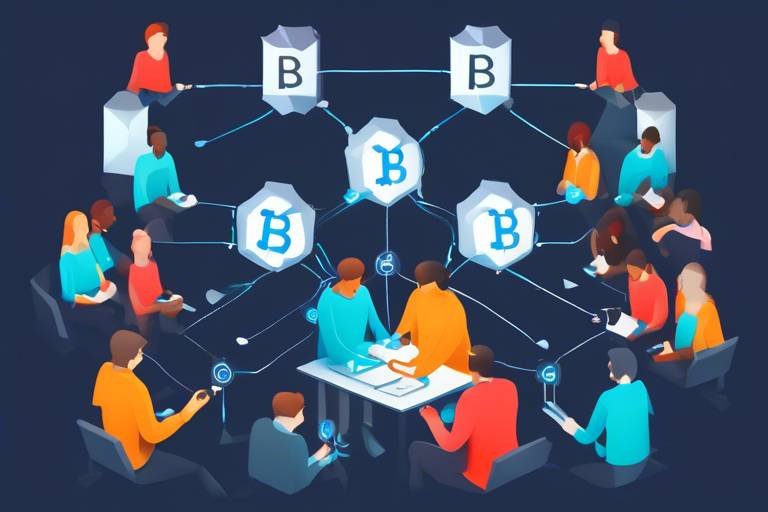How to Develop a Blockchain Use Case for Your Industry
In today's rapidly evolving technological landscape, the term blockchain has become a buzzword, often surrounded by a cloud of intrigue and potential. But how do you actually harness this technology for your specific industry? This article explores the essential steps and considerations for creating a blockchain use case tailored to your unique needs, highlighting its potential benefits and implementation strategies. Whether you're in finance, healthcare, supply chain, or any other sector, understanding how to develop a relevant use case can set you apart from the competition and drive innovation.
Before diving into the nitty-gritty of use case development, it’s crucial to have a foundational knowledge of blockchain technology. At its core, blockchain is a distributed ledger technology that ensures transparency, security, and immutability of data. Imagine a digital notebook that everyone can see but no one can erase; that’s blockchain in a nutshell. Its core principles include decentralization, cryptography, and consensus mechanisms, which work together to create a robust framework for data management. These features make blockchain an attractive solution for various industries, as it can enhance trust and efficiency in transactions.
To create an effective blockchain use case, it's essential to first identify the specific challenges faced by your industry. What keeps you up at night? What processes are slow, cumbersome, or fraught with errors? Common pain points that blockchain can address include issues like data integrity, transaction speed, and security vulnerabilities. By understanding these challenges, you can pave the way for innovative solutions that leverage blockchain’s unique capabilities.
Examining existing processes within your industry is like taking a magnifying glass to your workflow. It helps pinpoint inefficiencies and bottlenecks that could be streamlined with blockchain technology. Ask yourself: Are there redundancies in your data entry? Is there a lack of transparency in transactions? By assessing your current workflows, you can identify areas where blockchain can add significant value, transforming your operations from clunky to sleek.
Understanding the needs of various stakeholders is vital to developing a successful blockchain use case. Different players in your industry will have different expectations and requirements. Engage with them through interviews, surveys, or focus groups to gather insights that inform your blockchain strategy. This engagement not only helps you tailor your solution but also fosters a sense of ownership among stakeholders, increasing the likelihood of acceptance and success.
Compliance is crucial in any industry, especially when it comes to adopting new technologies like blockchain. The regulatory landscape can be complex and varies significantly across sectors and regions. As you develop your use case, it’s essential to address these considerations upfront. Research the regulations that apply to your industry and consult with legal experts to ensure that your blockchain implementation aligns with existing laws. This proactive approach can save you from potential pitfalls down the line.
Clear objectives are essential for success. Without them, your blockchain project could drift aimlessly. Take the time to articulate the goals of your use case, ensuring they align with your broader business strategies. Are you looking to enhance transparency, reduce costs, or improve customer trust? Whatever your objectives may be, make sure they are specific, measurable, achievable, relevant, and time-bound (SMART). This clarity will guide your project from inception to execution.
Once objectives are set, the next step is designing the blockchain solution. This involves choosing the right blockchain platform and architecture that fits your use case. Consider factors like scalability, security, and ease of integration with existing systems. The right design can make or break your project, so take the time to weigh your options carefully.
Different blockchain types serve different purposes. You’ll need to decide between public, private, and consortium blockchains based on your specific needs. Public blockchains are open to everyone and provide high transparency, while private blockchains offer more control and privacy. Consortium blockchains, on the other hand, are a middle ground, allowing a group of organizations to collaborate securely. Understanding these distinctions will help you make an informed choice that aligns with your use case objectives.
Seamless integration is key to success. Your blockchain solution should not exist in a vacuum; it needs to work in harmony with your existing systems and processes. This may involve technical challenges, but with the right strategies, you can create a cohesive ecosystem that enhances efficiency and reduces friction.
Implementation is where plans become reality. This stage involves executing the steps necessary for successfully deploying your blockchain use case, from pilot testing to full-scale rollout. A well-structured implementation plan can make the difference between a successful project and a failed one.
Launching a pilot program allows for testing in a controlled environment. It’s like dipping your toes in the water before diving in headfirst. This part will guide you through designing and executing a pilot that validates your use case before full implementation. Gather feedback, analyze results, and make adjustments as necessary to ensure a smooth transition to a full-scale rollout.
Continuous monitoring is essential for improvement. After implementation, it's crucial to evaluate the performance of your blockchain use case regularly. Collect data, solicit feedback, and analyze the results to make necessary adjustments. This iterative process ensures that your solution remains effective and aligned with your objectives over time.
- What industries can benefit from blockchain technology? Blockchain can be applied across various sectors, including finance, healthcare, supply chain, real estate, and more.
- How do I know if blockchain is right for my business? Assess your current challenges and objectives. If you face issues related to transparency, security, or efficiency, blockchain could be a viable solution.
- What are the costs associated with implementing a blockchain solution? Costs can vary widely based on the complexity of the solution, the technology stack chosen, and the scale of implementation. It's essential to conduct a thorough cost-benefit analysis.
- Is blockchain technology secure? While blockchain offers enhanced security features, no system is entirely foolproof. It's important to implement additional security measures alongside blockchain.

Understanding Blockchain Technology
To truly harness the power of blockchain, it's essential to have a solid grasp of what it is and how it operates. At its core, blockchain technology is a decentralized digital ledger that records transactions across many computers in such a way that the registered transactions cannot be altered retroactively. This means once a transaction is recorded, it becomes part of a permanent record, which is both transparent and secure. Think of it like a digital notebook that everyone can see but no one can erase.
One of the most significant features of blockchain is its decentralization. Unlike traditional databases that are controlled by a central authority, blockchain operates on a peer-to-peer network. This decentralization enhances security and trust, as there is no single point of failure. Imagine a group of friends all keeping their own copies of a shared journal; if one journal is lost, the others still hold the complete story.
Another key principle is immutability. Once data is added to a blockchain, it is nearly impossible to change. This characteristic is achieved through cryptographic hashing, which links blocks of data together in a way that any alteration would require changing all subsequent blocks, making it incredibly difficult for anyone to tamper with the information. This is akin to sealing a letter with wax; once sealed, it’s evident if someone has tried to open it.
Furthermore, blockchain technology incorporates transparency. Every participant in the network can access the entire history of transactions, fostering trust among users. This transparency can be particularly beneficial in industries where accountability is crucial, such as finance or supply chain management. For instance, if a product is traced back to its origin, consumers can verify its authenticity, ensuring they are getting what they paid for.
To summarize, understanding blockchain technology involves recognizing its core principles: decentralization, immutability, and transparency. These features are what make blockchain a revolutionary technology with the potential to transform various industries. As we delve deeper into developing a use case for your specific industry, keep these principles in mind, as they will guide your approach and decision-making process.

Identifying Industry Challenges
Identifying the specific challenges within your industry is a pivotal step in developing a blockchain use case. Every industry has its unique set of hurdles, and understanding these pain points is essential to leverage blockchain technology effectively. So, what are some of the common issues that businesses face today? Well, let's dive deeper into this.
For starters, many industries grapple with inefficiencies in their existing processes. Whether it's slow transaction speeds, lack of transparency, or difficulty in tracking assets, these inefficiencies can lead to significant financial losses and missed opportunities. Imagine a supply chain where every link is mired in delays and miscommunication—it's a recipe for disaster! Blockchain can step in here, providing a transparent and tamper-proof ledger that enhances trust and speeds up transactions.
Moreover, data security is a pressing concern across various sectors. With increasing cyber threats, industries like finance, healthcare, and retail are constantly on the lookout for robust solutions to safeguard sensitive information. Blockchain offers a decentralized approach to data storage, making it significantly harder for hackers to compromise the system. So, if data breaches are keeping you up at night, blockchain could be your knight in shining armor.
Another challenge that many organizations face is regulatory compliance. Navigating the complex web of regulations can be daunting, especially in industries like finance and healthcare. Blockchain can help streamline compliance processes by providing immutable records that can be easily audited. This not only saves time but also reduces the risk of non-compliance, which can be costly and damaging to a company's reputation.
Lastly, let’s not overlook the issue of costs. Many businesses struggle with high operational costs due to outdated systems and processes. By implementing a blockchain solution, organizations can reduce overhead costs associated with intermediaries and manual processes. Think of blockchain as a way to cut through the red tape and streamline operations, ultimately saving money in the long run.
In summary, identifying industry challenges is not just about recognizing problems; it's about uncovering opportunities for innovation. By understanding the inefficiencies, security concerns, compliance issues, and cost-related challenges, you can tailor a blockchain use case that not only addresses these pain points but also drives your business forward. So, take a step back, analyze your industry landscape, and get ready to transform challenges into opportunities!
- What are the main challenges industries face that blockchain can solve? Common challenges include inefficiencies, data security concerns, regulatory compliance, and high operational costs.
- How can blockchain improve data security? Blockchain provides a decentralized and tamper-proof way to store data, making it more resistant to cyber threats.
- Is compliance easier with blockchain? Yes, blockchain can simplify compliance by offering immutable records that are easy to audit.
- Can blockchain reduce operational costs? Absolutely! By eliminating intermediaries and streamlining processes, blockchain can significantly lower operational expenses.

Analyzing Current Processes
When it comes to developing a blockchain use case, the first step is to take a deep dive into the existing processes within your industry. Think of it as putting on a detective's hat—you're not just looking for clues; you're uncovering the inefficiencies that could be transformed through blockchain technology. This analysis is crucial because it helps you identify where the real pain points lie and how blockchain can swoop in like a superhero to save the day.
Start by mapping out the workflows currently in place. This involves gathering data on how tasks are performed, who is involved, and what tools are being used. It's essential to ask questions like: Are there delays in communication? Is data being duplicated across systems? Are there bottlenecks that slow down processes? By answering these questions, you can pinpoint areas ripe for improvement.
For instance, consider a supply chain scenario. If you notice that product tracking is cumbersome and prone to errors, this is a clear indication that blockchain could enhance transparency and traceability. By creating an immutable ledger, every participant in the supply chain can access real-time information, reducing discrepancies and fostering trust. Here's a quick overview of how analyzing current processes can reveal opportunities:
| Current Process | Identified Issue | Blockchain Opportunity |
|---|---|---|
| Manual Data Entry | High error rates | Automated data recording with smart contracts |
| Document Sharing | Slow and insecure | Decentralized document storage |
| Payment Processing | High transaction fees | Direct peer-to-peer payments |
By conducting this thorough analysis, you not only identify inefficiencies but also begin to envision how blockchain can revolutionize your operations. Remember, the goal is to create a streamlined process that enhances productivity and reduces costs. As you gather insights, engage with team members involved in these processes. Their firsthand experience can provide valuable perspectives that may not be immediately obvious. This collaborative approach ensures that your blockchain use case is not only innovative but also practical and aligned with the needs of your organization.
In conclusion, analyzing current processes is a vital step in the journey toward implementing a successful blockchain solution. By understanding where the challenges lie, you can craft a use case that addresses these issues head-on, setting the stage for a transformative impact on your industry.
- What is the first step in developing a blockchain use case?
Analyzing current processes within your industry to identify inefficiencies and pain points. - How can blockchain improve supply chain management?
By providing real-time tracking, reducing errors, and enhancing transparency through an immutable ledger. - Why is stakeholder engagement important?
Engaging stakeholders ensures that the blockchain use case aligns with their needs and addresses real-world challenges.

Mapping Stakeholder Needs
When it comes to developing a blockchain use case, understanding and mapping the needs of your stakeholders is not just important—it's absolutely crucial. Think of stakeholders as the various players in a game; each one has their own goals, concerns, and motivations that can significantly influence the outcome of your project. If you want to win this game, you need to know what each player is looking for and how they interact with one another.
Start by engaging with your stakeholders directly. This could involve interviews, surveys, or even informal conversations. The goal here is to gather insights that will inform your blockchain use case. For instance, if you're in the supply chain industry, your stakeholders might include suppliers, manufacturers, distributors, and even consumers. Each of these groups will have different perspectives on what they want from a blockchain solution.
Here are some common stakeholder needs that you might encounter:
- Transparency: Many stakeholders want to see clear, verifiable records of transactions.
- Efficiency: Reducing time and costs associated with processes is often a primary concern.
- Security: Stakeholders are likely to be worried about the safety of their data and transactions.
- Compliance: Adhering to industry regulations is a must for many businesses.
After collecting this information, it’s essential to analyze and prioritize the needs. Not all stakeholder requirements will carry the same weight, and some may even conflict with one another. By creating a stakeholder map, you can visually represent the relationships and priorities among different groups. This map will serve as a guiding document as you develop your blockchain use case.
Additionally, consider setting up regular feedback loops with your stakeholders. This iterative approach will not only help you refine your use case but also build trust among all parties involved. When stakeholders feel heard and valued, they are more likely to support the implementation of your blockchain solution.
In summary, mapping stakeholder needs is not just a step in the process; it’s a foundational pillar that can make or break your blockchain initiative. By actively engaging and understanding your stakeholders, you can create a solution that meets their needs and drives your project toward success.
Q1: Why is mapping stakeholder needs important in blockchain projects?
A1: Mapping stakeholder needs is essential because it helps you understand the diverse goals and concerns of all parties involved. This understanding can guide your blockchain use case development and ensure that it addresses the right issues.
Q2: How can I effectively gather stakeholder insights?
A2: You can gather insights through interviews, surveys, focus groups, or even informal discussions. The key is to engage with stakeholders directly to understand their perspectives.
Q3: What is a stakeholder map?
A3: A stakeholder map is a visual representation of the relationships and priorities among different stakeholders. It helps you identify who influences the project and how their needs align or conflict.
Q4: How often should I communicate with stakeholders during the blockchain implementation?
A4: Regular communication is vital. Establish feedback loops that allow stakeholders to voice their opinions and provide input throughout the development process.

Evaluating Regulatory Considerations
When diving into the world of blockchain, one cannot overlook the crucial aspect of regulatory considerations. As exciting as this technology is, it operates within a framework of laws and regulations that can vary significantly from one region to another. Understanding these regulations is not just a box to check off but a fundamental step in ensuring that your blockchain use case is viable and sustainable in the long run.
First and foremost, it's important to recognize that blockchain technology is still relatively new, and as such, regulatory bodies are continually evolving their approaches to it. This means that what might be compliant today could change tomorrow. For instance, in some jurisdictions, cryptocurrencies are treated as assets, while in others, they might be classified as currencies or even securities. This inconsistency can lead to confusion and potential legal pitfalls if not addressed early in the development process.
To navigate this complex landscape, consider the following key areas:
- Data Privacy: Regulations such as GDPR in Europe impose strict rules on how personal data can be collected, stored, and processed. Ensure that your blockchain solution complies with these regulations, especially if it involves sensitive user data.
- Anti-Money Laundering (AML) and Know Your Customer (KYC): Many jurisdictions require businesses to implement AML and KYC procedures to prevent illicit activities. Incorporating these measures into your blockchain use case is essential for compliance.
- Tax Obligations: Understanding how your blockchain transactions will be taxed is crucial. Different types of transactions may have different tax implications, so consulting with a tax professional is advisable.
Moreover, engaging with legal experts who specialize in blockchain and technology law can provide invaluable insights. They can help you interpret regulations, identify potential risks, and ensure that your project aligns with both local and international laws. It's also beneficial to keep an eye on industry trends and participate in forums or groups that discuss regulatory changes. This proactive approach can help you stay ahead of the curve and adapt your use case accordingly.
In conclusion, evaluating regulatory considerations is not just about compliance; it's about building a trustworthy and resilient blockchain solution. By understanding the legal landscape and implementing the necessary measures, you can pave the way for a successful deployment that not only meets regulatory standards but also earns the confidence of your stakeholders.
Q1: What are the key regulations affecting blockchain technology?
A1: Key regulations include data privacy laws (like GDPR), anti-money laundering (AML) laws, and tax obligations, which can vary widely by jurisdiction.
Q2: How can I ensure my blockchain use case is compliant?
A2: Engage with legal experts in blockchain technology, stay updated on regulatory changes, and implement necessary compliance measures from the outset.
Q3: What should I do if regulations change after my blockchain project is launched?
A3: Regularly monitor regulatory updates and be prepared to adapt your project as necessary to maintain compliance and avoid legal issues.

Defining Use Case Objectives
When it comes to developing a blockchain use case, defining clear and actionable objectives is like setting the compass for your journey. Without a well-defined direction, you may find yourself wandering aimlessly, unsure of how to leverage this transformative technology effectively. So, what exactly should you aim for? First and foremost, consider the specific problems you want to solve within your industry. This could range from enhancing transparency in supply chains to improving data security in financial transactions.
Next, think about how these objectives align with your broader business strategies. Are you looking to increase operational efficiency, reduce costs, or perhaps create new revenue streams? By articulating your goals, you not only create a roadmap for your project but also set the stage for measuring success. Remember, clear objectives should be SMART: Specific, Measurable, Achievable, Relevant, and Time-bound. For instance, instead of saying, "We want to improve customer satisfaction," you could say, "We aim to reduce customer service response time by 50% within six months." This specificity makes it easier to track progress and make adjustments as needed.
Moreover, engaging stakeholders during this phase is crucial. They can provide valuable insights that help refine your objectives. Create a collaborative environment where different perspectives are welcomed. This could involve workshops or brainstorming sessions where stakeholders can voice their concerns and aspirations. By doing so, you ensure that your use case is not only technically sound but also addresses real-world needs.
To illustrate the importance of defining use case objectives, consider the following table that outlines potential objectives along with their corresponding benefits:
| Objective | Benefit |
|---|---|
| Enhance Transparency | Build trust among stakeholders by providing real-time visibility into transactions. |
| Reduce Costs | Minimize operational costs by automating processes and reducing intermediaries. |
| Improve Security | Protect sensitive data through cryptographic methods inherent in blockchain. |
| Increase Efficiency | Streamline processes, leading to faster transaction times and improved workflows. |
In conclusion, defining your use case objectives is a critical step that lays the groundwork for a successful blockchain implementation. By focusing on specific challenges, aligning with business strategies, and engaging stakeholders, you can create a robust framework that ensures your blockchain initiative hits the mark. So, take the time to carefully craft your objectives; they will serve as your guiding light throughout the development process.
- What are the key elements of a successful blockchain use case? A successful use case should address a specific industry challenge, have clear objectives, and involve stakeholder engagement.
- How do I measure the success of my blockchain use case? Success can be measured using the SMART criteria, focusing on specific metrics aligned with your defined objectives.
- Can blockchain be integrated with existing systems? Yes, integrating blockchain with existing systems is crucial for its success and can be achieved through careful planning and design.

Designing the Blockchain Solution
Once you have clearly defined the objectives of your blockchain use case, the next step is to design the blockchain solution. This phase is crucial, as it will determine how effectively your blockchain can address the identified challenges and meet the needs of your stakeholders. The design process involves selecting the right blockchain platform and architecture that aligns with your specific requirements. It's a bit like building a house; you wouldn't choose a roof before you have a solid foundation. Similarly, you need to ensure that the underlying technology supports your goals.
When it comes to choosing a blockchain platform, there are several factors to consider. You need to determine whether a public, private, or consortium blockchain is the best fit for your use case. Public blockchains, like Bitcoin and Ethereum, are open to anyone and are ideal for applications where transparency and decentralization are paramount. On the other hand, private blockchains are more controlled environments, suitable for businesses that prioritize privacy and speed over complete openness. Consortium blockchains, which are governed by a group of organizations, can be a middle ground, offering some benefits of both public and private blockchains.
To help you visualize this decision-making process, consider the following table:
| Blockchain Type | Characteristics | Best Use Cases |
|---|---|---|
| Public | Open to anyone, decentralized, high transparency | Currencies, crowdfunding, public records |
| Private | Controlled access, faster transactions, privacy-focused | Internal business processes, supply chain management |
| Consortium | Limited access, shared governance, collaborative | Industry collaborations, joint ventures |
After selecting the appropriate blockchain type, the next step is to consider how your blockchain solution will integrate with existing systems. This is where the magic of synergy happens—your new solution should complement and enhance your current processes rather than disrupt them. Think of it as adding a new ingredient to a recipe; it should enhance the flavor without overpowering the dish. To achieve seamless integration, you may need to engage with IT teams and stakeholders to ensure that the new technology aligns with existing workflows and data management practices.
Moreover, it’s essential to consider the scalability of your blockchain solution. As your business grows, the blockchain should be able to handle increased transactions and data without compromising performance. This is akin to choosing a vehicle; you want one that can accommodate your current needs while also being capable of handling future demands. Therefore, you might want to explore platforms that offer scalability options, such as sharding or layer-2 solutions.
Lastly, don’t forget about the user experience. A blockchain solution that is difficult to use will likely face resistance from stakeholders. Thus, it’s important to design an intuitive interface that simplifies interactions with the blockchain. Think about how you feel when you use your favorite app—smooth, seamless, and satisfying. Striving for a similar experience in your blockchain application can significantly enhance adoption and overall success.
In summary, designing your blockchain solution involves selecting the right type of blockchain, ensuring seamless integration with existing systems, considering scalability, and focusing on user experience. By taking these factors into account, you can create a robust and effective blockchain solution that not only meets your current needs but is also adaptable for future growth.
- What is the most important factor when designing a blockchain solution? The most important factor is aligning the blockchain type with your specific use case and industry requirements.
- How can I ensure my blockchain solution is user-friendly? Involve end-users in the design process to gather feedback and create an intuitive interface.
- What are some common challenges in blockchain integration? Common challenges include data compatibility, system interoperability, and ensuring stakeholder buy-in.

Selecting the Right Blockchain Type
When it comes to , it's crucial to understand that not all blockchains are created equal. Each type serves a different purpose and comes with its unique set of features and limitations. This decision can significantly impact the success of your blockchain use case, so let's break it down.
There are three primary types of blockchains: public, private, and consortium. Each one has its own characteristics that make it suitable for specific applications. Understanding these differences is like choosing the right tool for a job; using a hammer to drive screws can lead to a frustrating experience, just as selecting the wrong blockchain might derail your project.
Public blockchains are open to everyone and are typically decentralized. They operate on a peer-to-peer network where anyone can join, validate transactions, and access the ledger. The most famous example is Bitcoin. Public blockchains are excellent for applications requiring transparency and trust, such as cryptocurrencies or decentralized applications (dApps). However, their openness can also lead to slower transaction speeds and scalability issues, so if you're looking for speed and efficiency, you might want to consider other options.
On the other hand, private blockchains are restricted to a specific group of users. They offer greater control and privacy, making them ideal for businesses that need to maintain confidentiality while still leveraging the benefits of blockchain technology. For instance, a private blockchain could be used within a corporation for supply chain management, allowing only authorized personnel to access sensitive data. However, the trade-off is that they can be less transparent and may not foster the same level of trust among participants.
Finally, consortium blockchains sit somewhere in between public and private. They are governed by a group of organizations rather than a single entity, making them suitable for industries where multiple stakeholders need to collaborate. Think of it as a club where only selected members can participate. This type of blockchain can enhance transparency and trust among members while still keeping sensitive data secure. Consortium blockchains are often used in sectors like finance and healthcare, where collaboration is essential but privacy is also a priority.
To help you visualize these distinctions, here's a quick comparison table:
| Blockchain Type | Access | Use Cases | Transparency | Control |
|---|---|---|---|---|
| Public | Open to everyone | Cryptocurrencies, dApps | High | Low |
| Private | Restricted access | Internal business processes | Low | High |
| Consortium | Selected members | Collaborative projects | Medium | Shared among members |
In conclusion, selecting the right blockchain type is a critical step in developing your use case. It's essential to align your choice with the specific needs of your industry and the goals you aim to achieve. Are you looking for transparency? A public blockchain might be your best bet. Need privacy and control? Consider a private blockchain. Or perhaps you're aiming for collaboration among multiple stakeholders? A consortium blockchain could be the answer. By understanding these options, you can make an informed decision that sets your project up for success.
- What is the main difference between public and private blockchains? Public blockchains are open to anyone, while private blockchains restrict access to specific users or organizations.
- Can I switch from one type of blockchain to another? While it's possible, switching blockchains can be complex and may require significant changes to your infrastructure and processes.
- Which blockchain type is best for my business? It depends on your specific needs, such as the level of transparency required, the number of stakeholders involved, and how much control you want over the data.

Integrating with Existing Systems
Integrating a new blockchain solution with existing systems is like trying to fit a square peg into a round hole; it requires careful planning, creativity, and sometimes a bit of elbow grease. As you embark on this journey, it's essential to recognize that most organizations already have established workflows, software, and protocols in place. The challenge lies in ensuring that your blockchain technology complements and enhances these systems rather than disrupting them.
First, you need to conduct a thorough analysis of your current infrastructure. This involves understanding the various components of your existing systems, such as databases, applications, and communication protocols. You might ask questions like, "How does data flow through our systems?" or "What are the key pain points that our current setup creates?" By answering these questions, you can identify integration points where blockchain can add value.
Next, consider the technical compatibility of your blockchain solution with existing systems. For instance, if your current systems rely heavily on SQL databases, you might need to explore blockchain platforms that offer APIs or connectors that facilitate communication between the blockchain and your databases. Moreover, it’s crucial to ensure that the blockchain solution can handle the data formats and protocols used by your current systems. A mismatch here can lead to data silos or, worse, data loss.
Another critical aspect of integration is the user experience. Your employees are the ones who will be using the new system daily, so it’s vital to ensure that the integration feels seamless. This could involve designing user interfaces that allow employees to interact with both the blockchain and existing systems without needing extensive training. For example, if your team is accustomed to a specific dashboard or reporting tool, integrating blockchain data into that familiar interface can ease the transition.
Additionally, consider the security implications of integrating blockchain with existing systems. Blockchain technology offers enhanced security features, but integrating it poorly can introduce vulnerabilities. Ensure that data transferred between systems is encrypted and that access controls are robust. Implementing a comprehensive security strategy should be a priority during the integration process.
Finally, it’s advisable to adopt an iterative approach to integration. Instead of trying to overhaul everything at once, start with small, manageable projects that allow you to test the waters. For instance, you could pilot a specific use case that leverages blockchain for a particular process, gather feedback, and refine the integration before a full-scale rollout. This method not only minimizes risk but also helps in building confidence among stakeholders.
In conclusion, integrating blockchain with existing systems is not just a technical challenge; it’s an opportunity to enhance your organization’s capabilities. By carefully analyzing your current infrastructure, ensuring compatibility, focusing on user experience, addressing security concerns, and adopting an iterative approach, you can create a cohesive ecosystem where blockchain and existing systems work hand in hand. This not only boosts operational efficiency but also positions your organization for future growth in an increasingly digital world.
- What are the key benefits of integrating blockchain with existing systems?
Integrating blockchain can enhance transparency, improve data security, and streamline processes by automating workflows. - How do I determine the right blockchain platform for integration?
Consider factors like scalability, compatibility with existing systems, and the specific needs of your use case when selecting a blockchain platform. - What challenges might I face during integration?
Common challenges include technical compatibility issues, resistance to change from staff, and ensuring data security throughout the integration process. - Is it necessary to train staff on the new system?
Yes, training is crucial to ensure that employees can effectively use the integrated systems and understand the benefits of blockchain technology.

Implementing the Use Case
Implementation is where the magic happens! After all the brainstorming, planning, and designing, it's time to roll up your sleeves and bring your blockchain use case to life. But hold on a second! Before you dive in, let’s take a moment to understand that successful implementation requires more than just technical know-how; it’s about strategic execution and continuous improvement.
First things first, you’ll want to create a pilot program. Think of this as your test drive before you hit the open road. A pilot program allows you to test your blockchain solution in a controlled environment, minimizing risks while maximizing learning opportunities. During this phase, you can gather valuable feedback, identify potential pitfalls, and make necessary adjustments before a full-scale rollout. It’s like fine-tuning an instrument before a big concert; you want everything to sound just right!
When designing your pilot program, consider the following key aspects:
- Scope: Define what the pilot will cover. Will it be a specific department or a particular process?
- Duration: Set a timeline for how long the pilot will run. This helps in evaluating its effectiveness.
- Metrics: Establish clear performance indicators to measure success. What does success look like for your use case?
Once your pilot is up and running, the next step is to focus on monitoring and evaluation. Continuous monitoring is crucial for improvement. You’ll want to keep a close eye on how the blockchain solution performs against the metrics you’ve set. Are you achieving the desired outcomes? Are there any unexpected challenges cropping up? This is where data analysis comes into play. By analyzing the data collected during the pilot, you can gain insights that are pivotal for refining your blockchain use case.
Moreover, don’t overlook the importance of stakeholder feedback during this phase. Engaging with stakeholders regularly will provide you with diverse perspectives and ideas that could enhance your implementation strategy. Remember, it’s not just about technology; it’s about people too!
After the pilot program has been thoroughly evaluated and any necessary adjustments have been made, it’s time for the big launch! A full-scale rollout means that your blockchain solution is now ready to be integrated into all relevant areas of your organization. However, this isn’t a “set it and forget it” scenario. You’ll need to keep the lines of communication open and remain flexible to adapt to any new challenges that may arise.
In summary, implementing a blockchain use case is an exciting journey that combines careful planning, execution, and continuous improvement. By starting with a pilot program, closely monitoring performance, and engaging with stakeholders, you’ll be well on your way to successfully integrating blockchain technology into your industry.
Here are some common questions that often arise during the implementation of a blockchain use case:
- What are the initial steps for implementing a blockchain solution? Start by defining your objectives, identifying stakeholders, and creating a pilot program.
- How long should a pilot program last? Typically, a pilot program can last from a few weeks to several months, depending on the complexity of the use case.
- What metrics should I use to evaluate success? Metrics can vary, but common ones include transaction speed, cost savings, and stakeholder satisfaction.
- How can I ensure stakeholder engagement? Regular communication, feedback sessions, and workshops can help keep stakeholders involved and invested in the process.

Creating a Pilot Program
Launching a pilot program is a crucial step in the journey of implementing a blockchain use case. Think of it as a test drive before committing to a long-term investment. It allows you to explore the potential of your blockchain solution in a controlled environment, minimizing risks while maximizing learning opportunities. By starting small, you can validate your assumptions, gather feedback, and make necessary adjustments before a full-scale rollout.
So, how do you go about creating an effective pilot program? First, you need to define the scope of your pilot. This involves identifying the specific objectives you want to achieve, such as testing a particular feature of the blockchain or assessing its impact on a specific process. Clarity in your goals will guide your pilot's design and execution.
Next, select a representative sample of users or processes to include in your pilot. This is where you can really dig into the details. For instance, if your blockchain solution is aimed at supply chain management, consider piloting it with a specific product line or a limited number of suppliers. This focused approach allows you to gather meaningful insights without overwhelming your team or stakeholders.
Once you've defined the scope and selected your sample, it's time to develop a detailed plan. This plan should outline:
- The timeline for the pilot program
- The metrics you will use to measure success
- The resources required, including technology and personnel
- The potential risks and how you plan to mitigate them
After planning, the next step is execution. Engage your stakeholders throughout the process, keeping communication lines open. This will not only help in addressing any concerns that may arise but also foster a sense of ownership among participants. Remember, a pilot is not just about technology; it's also about people.
Finally, once the pilot program is underway, it's essential to monitor its progress closely. Collect data on the established metrics and gather feedback from participants. This information is invaluable for evaluating the pilot's success and determining whether your blockchain use case is ready for a broader implementation.
In summary, creating a pilot program is an iterative process that allows you to test, learn, and refine your blockchain solution. By following these steps, you can ensure that when it comes time to scale up, you are well-prepared and confident in the value your blockchain use case brings to your industry.
Q1: What is the purpose of a pilot program in blockchain implementation?
A pilot program helps test the feasibility and effectiveness of a blockchain solution in a controlled environment, allowing for adjustments based on real-world feedback before full-scale deployment.
Q2: How long should a pilot program last?
The duration of a pilot program can vary depending on the objectives and complexity of the use case, but it typically ranges from a few weeks to several months.
Q3: What metrics should I track during the pilot?
Metrics may include transaction speed, cost savings, user satisfaction, and overall impact on the processes being tested. Choose metrics that align with your specific goals.
Q4: How do I gather feedback from pilot participants?
Feedback can be collected through surveys, interviews, or regular check-ins, ensuring participants feel comfortable sharing their experiences and suggestions.

Monitoring and Evaluation
Once your blockchain use case is up and running, the real work begins with . This phase is crucial as it ensures that your implementation is not just a one-off project but a sustainable solution that evolves with the needs of your organization. Think of it like tuning a musical instrument; you want to make sure everything stays in harmony as you progress. So, how do you effectively monitor and evaluate your blockchain solution?
First and foremost, establish key performance indicators (KPIs) that align with your initial objectives. These KPIs will serve as the benchmarks against which you assess the success of your blockchain implementation. For example, if your goal was to enhance transaction speed, then measuring the average time taken for transactions before and after implementation would be a relevant KPI. Consider the following categories for KPIs:
| Category | Example KPIs |
|---|---|
| Efficiency | Transaction speed, cost savings |
| Security | Number of breaches, data integrity |
| User Adoption | Number of active users, feedback ratings |
Next, implement a robust feedback loop. This means actively seeking out input from users and stakeholders who interact with the blockchain system. Their insights can reveal unforeseen issues or opportunities for improvement that you might not have considered. Think of it as gathering the audience's feedback after a show; their reactions can guide your next performance. You can utilize surveys, interviews, or even informal discussions to collect this valuable feedback.
Additionally, regularly review your data analytics. Blockchain technology offers unparalleled transparency and traceability, allowing you to analyze transaction data in real-time. By leveraging analytics tools, you can uncover patterns, identify bottlenecks, and even predict future trends. This data-driven approach enables you to make informed decisions that can lead to continuous improvement.
Finally, be prepared to iterate. The beauty of blockchain is its flexibility, allowing you to adapt your solution based on the insights gathered from monitoring and evaluation. If certain aspects of your implementation are not meeting expectations, don’t hesitate to pivot. This iterative process is akin to fine-tuning a recipe; sometimes, a dash more salt or a sprinkle of spice can elevate the dish to perfection.
In summary, effective monitoring and evaluation of your blockchain use case is not just about checking boxes; it’s about fostering a culture of continuous improvement. By establishing KPIs, engaging with stakeholders, analyzing data, and being open to iteration, you can ensure that your blockchain solution remains relevant and effective in addressing your industry’s challenges.
- What is the importance of monitoring in blockchain? Monitoring allows organizations to assess the effectiveness of their blockchain implementation, ensuring it meets its objectives and evolves with changing needs.
- How often should I evaluate my blockchain use case? Regular evaluations are recommended, ideally on a quarterly basis, to ensure timely adjustments can be made based on performance data and stakeholder feedback.
- What tools can I use for monitoring blockchain performance? Various analytics tools and dashboards can help track KPIs, transaction speeds, and user engagement metrics effectively.
Frequently Asked Questions
- What is blockchain technology?
Blockchain technology is a decentralized digital ledger that records transactions across many computers in such a way that the registered transactions cannot be altered retroactively. This ensures transparency and security, making it a revolutionary tool for various industries.
- How can blockchain benefit my industry?
Blockchain can address numerous challenges like enhancing transparency, improving security, reducing costs, and increasing efficiency. By providing a clear, immutable record of transactions, it can help build trust among stakeholders and streamline operations.
- What are the key steps in developing a blockchain use case?
Developing a blockchain use case involves several steps: understanding the technology, identifying industry challenges, analyzing current processes, mapping stakeholder needs, evaluating regulatory considerations, defining objectives, designing the solution, and implementing the use case.
- How do I identify challenges in my industry that blockchain can solve?
Start by examining your industry's pain points, such as inefficiencies, lack of transparency, or security concerns. Engaging with stakeholders and conducting thorough market research can provide insights into specific challenges that blockchain can effectively address.
- What types of blockchain are available, and how do I choose one?
There are three main types of blockchain: public, private, and consortium. Your choice depends on your specific needs, such as the level of transparency required, the number of participants involved, and the degree of control you want over the network.
- What is a pilot program, and why is it important?
A pilot program is a small-scale implementation of your blockchain use case designed to test its feasibility and effectiveness in a controlled environment. It allows you to identify potential issues and make necessary adjustments before a full-scale rollout.
- How can I ensure compliance with regulations when implementing blockchain?
Staying informed about the regulatory landscape is crucial. Consult with legal experts and ensure that your blockchain solution adheres to industry-specific regulations and standards to avoid potential legal pitfalls.
- What should I monitor after implementing a blockchain solution?
After implementation, focus on monitoring performance metrics, user feedback, and any operational challenges that arise. Continuous evaluation will help you refine the solution and maximize its effectiveness over time.



















